2002.08.08 22:33
Congregation or Synagogue ?
Question:
In Architecture in Philadelphia: A Guide Louis Kahn's Ahavath Israel listed as a Synagogue, yet, when built, the building's sign (which is now gone) stated:
CONGREGATION
(Star of David)
AHAVATH ISRAEL
Is there a difference between a Congregation (building) and a Synagogue? Is it proper to refer to the building as Congregation Ahavath Israel rather than Ahavath Israel Synagogue?
2002.08.09 15:20
Re: Congregation or Synagogue ?
I/Quondam already have a cad model of Hurva Synagogue, and indeed there is reason to believe that Kent Larson got the idea to construct computer models from me--I had submitted a grant proposal to the Graham Foundation in 1991 involving the building of computer models of unbuilt designs. I did not receive the grant, but Kent Larson did receive a grant from the Graham foundation the following year for the same type of proposal. Beyond that, also in 1991, I published slides and drawings of Le Corbusier's Palais des Congres (unbuilt 1964) and offered them for sale to academic architecture libraries. Harvard, U of Oregon, Berkeley and Miami U, Ohio bought the slides, and Harvard also bought the drawings. Is it just coincidence that www.greatbuildings.com began out of U. of Oregon?
I revisited Ahavath Israel today, and sadly the facade has been changed, I was told circa 2000. The whole portion of the facade above the recessed entry is no longer brick, but now a salmon colored, textured CMU. This is yet another building to have changed since I last took pictures of it. The curse of Quondam I guess.
It dawned on me last night that both Wright's Beth Sholom and Kahn's Adath Jeshurun are hugely triangular in plan. Wright mailed the preliminary drawings to Rabbi Mortimer Cohen on 15 March 1954. Kahn's design is dated 1954-55. Since Beth Sholom and Adath Jeshurun are (next-door) neighboring congregations, it wouldn't surprise me at all if architectural rivalry between the congregations was going on, and that Kahn even saw the Wright plans before he came up with his design. Has anyone heard of this possible connection before?
ps
I've been doing a lot of Kahn building photographing this week. I've never seen that Trenton Bath House before, and it was just wonderful to see it. Today I was at Bryn Mawn College to photograph the Kahn dormitory exterior. The building is in the final stages of a full overhaul/restoration. The place was/is crawling with workmen, so I went in and found my way up to the roof. and what a great Kahnscape that is. Mill Creek Housing Project, Philadelphia is now completely abandoned and boarded up. Richards Medical Buildings, U of P, still looks good, but is hard to photograph because of tight quarters and lots of surrounding vegetation.
| |
2002.08.09 15:20
Re: Congregation or Synagogue ?
I revisited Ahavath Israel today, and sadly the facade has been changed, I was told circa 2000. The whole portion of the facade above the recessed entry is no longer brick, but now a salmon colored, textured CMU. This is yet another building to have changed since I last took pictures of it. The curse of Quondam I guess.
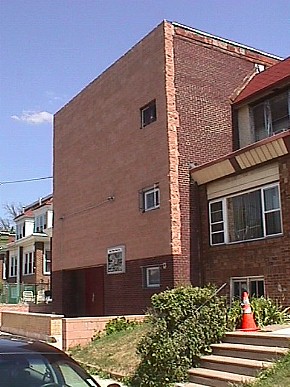
2002.08.11 13:23
Re: Kahn and Wright
Seeing the other day how Ahavath Israel Synagogue is now again changed was like a gift to me in that I was there looking because I'm working on Somewhat Incompletely Louis I. Kahn. I'm beginning to believe that the notion of incompleteness is exactly what's missing from design theory, teaching and practice, and, indeed, that an understanding of incompleteness could help remedy at least some of what you see as being so wrong today.
| |
2002.08.11 13:23
Re: Kahn and Wright
Second, I agree with what you say about the nixing of Giurgola's design additions to Kahn's buildings (Kimbell and Salk). In reading the recent New Yorker article on Serra, I was reminded of how much I enjoyed the controversy over Tilted Arc as it unfolded. I am no advocate of the notion that so-called site specific art is somehow 'above it all.' Time and the changes it brings is one reality that I believe no one can prove or demonstrate to be otherwise. I rather enjoy seeing, documenting, and learning from the changes that come with time. In the early nineties I thought it would be fun to make a cad model of the Federal Building with Tilted Arc, an idea that fit well with what became Quondam.
Seeing the other day how Ahavath Israel Synagogue is now again changed was like a gift to me in that I was there looking because I'm working on Somewhat Incompletely Louis I. Kahn. I'm beginning to believe that the notion of incompleteness is exactly what's missing from design theory, teaching and practice, and, indeed, that an understanding of incompleteness could help remedy at least some of what you see as being so wrong today.
In the radio interview of Hani Rashid (that Brian told us about), just over 13 minutes into the interview Rashid said, "There is a famous adage by Louie Kahn that really one doesn't get to build until they're in their early fifties." I'm not sure where this adage comes from exactly, nor if that is indeed what Kahn really said, but the reality is that Kahn (who turned 50 in 1951) had already build a whole lot of buildings between 1935 and 1951. Kahn's work, however, did not receive wide recognition until the Yale Art Gallery (1950-53) and then (for the buildings) after. [Another thing Rashid said is that his firm never expected their Virtual New York Stock Exchange project to receive all the recognition it did, which completely contradicts what Rashid said at the Anything conference (June 2000 I think), that is, that he pretty much demanded the clients of the project to publicize it!)
If I am ever commissioned to design and execute a building that's not virtual, I know full well that I could never do it all on my own, thus I'd employ and justly acknowledge the work of others. I kind of do that already when I publish the letters of others at Quondam and Museumpeace. The point being that often what I write is indeed intertwined with what others have also written. The only dilemma in that is if I package these texts for commercial sale, then I might also be infringing the copyright of other's intellectual property. [I'm still working on figuring out a good design for remedying that.]
Seeing the Trenton Bath House for the first time last week while it was very much being used, more or less convinced me that Kahn indeed learned (and then knew) a whole lot about architecture, particularly architecture's osmotic potential--that place's integration of outside and inside is nothing less than a "breath of fresh air."
| |
2002.08.12 15:45
recent observations
As I was driving down Spring Garden Street yesterday, a detail of Venturi and Rauch's Guild House caught my eye. The white brick wall either side of the recessed entrance (in contrast to the red brick of the rest of the building) immediately reminded me of the new two-tone masonry at Ahavath Israel. As RE can confirm, from the first time I saw Ahavath Israel in 1998, I got the sense that Guild House was somewhat of a faint reenactment of the synagogue. Now one could say that the original is reenacting its reenactment.
Later, while touring Manayunk with a friend that had never been there, I couldn't help but notice the storefront display of the Venturi, Scott Brown & Associates office on Main Street. On the window is a big sign that reads "Learning From Everything" and in the display area is a ladder and saw and a smaller sign hanging from the ladder that reads "under construction." Do you suppose that the message there delivered is indeed for they and us to now "learn from everything under construction?"
Tomorrow, if the window display is still the same, I'm going to take a picture of it and title the picture Learning from Everything Being Incomplete.
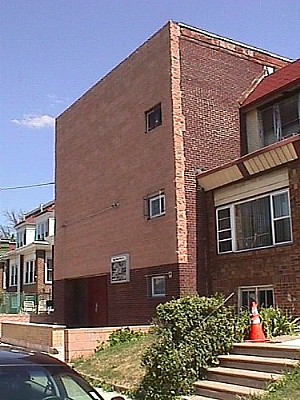 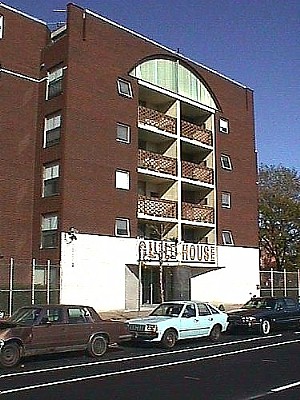
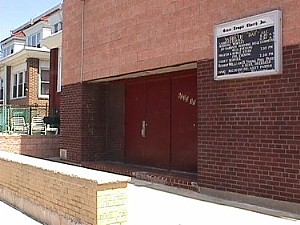 
 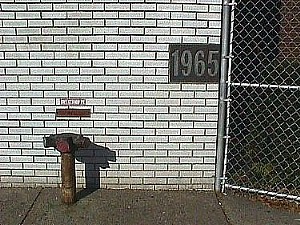
2002.08.12 18:08
more reenactment than I thought
In just comparing images of Ahavath Israel and Guild House, there are several features strikingly similar between the two building:
1. the 'main' facades projects out to the street and stand in contrast to the adjacent building (elements).
2. the entrances are ground level recesses within the main facade. (Interestingly, Ahavath Israel had three columns later installed within the recess to augment failing support of the wall above, columns that are now removed due to the new facade work, while Guild House always had an exaggerated column standing within the recess.)
3. the three individual windows symmetrically framing the center balconies of Guild House very much echo the three sole windows to one side of Ahavath Israel's otherwise facade.
4. the cornerstone setting/detailing of each building is virtual identical, except for the dates, of course--5698/1937 vs. 1965.
I am now reminded of an anecdote R. told me the day after I took R. and S. to see Ahavath Israel some Sunday morning October 2000. After our visit to the Kahn building, R. and S. went to have lunch with Robert Venturi and Denise Scott Brown. They told the famous architects about having just seen Kahn's first building. Venturi apparently acted in some kind of disbelief, as if the building didn't even exist. He said something like, "But it's not even in the catalogue!?!" I assume Venturi was referring the Louis I. Kahn: In The Realm of Architecture. R. told them to look up the (then) webpages at www.quondam.com that displayed images of the building.
I was immediately suspect of Venturi's apparent lack of knowledge of the building. Granted 1965 is a long time ago, and we all have incomplete memories. Nonetheless, Congregation Ahavath Israel (original sign and all) was very much featured within Vincent Scully's 1962 book Louis I. Kahn.
[Now imagine the computer screen you're looking at right now as an incomplete window display somewhere in Philadelphia, and repeat to yourself for the next 28 years, "Learning From Everything Venturi Forgot."]
|